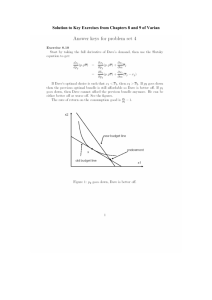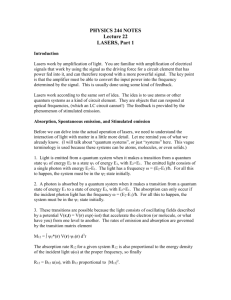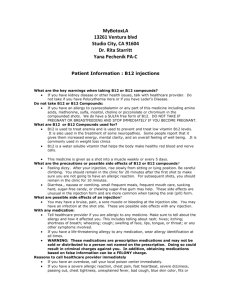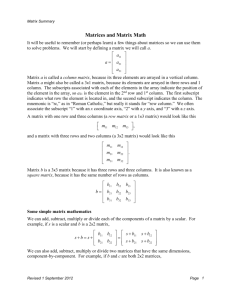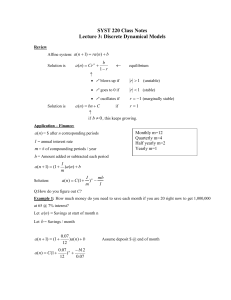The stability of a semi-implicit numerical scheme for a math biology
advertisement
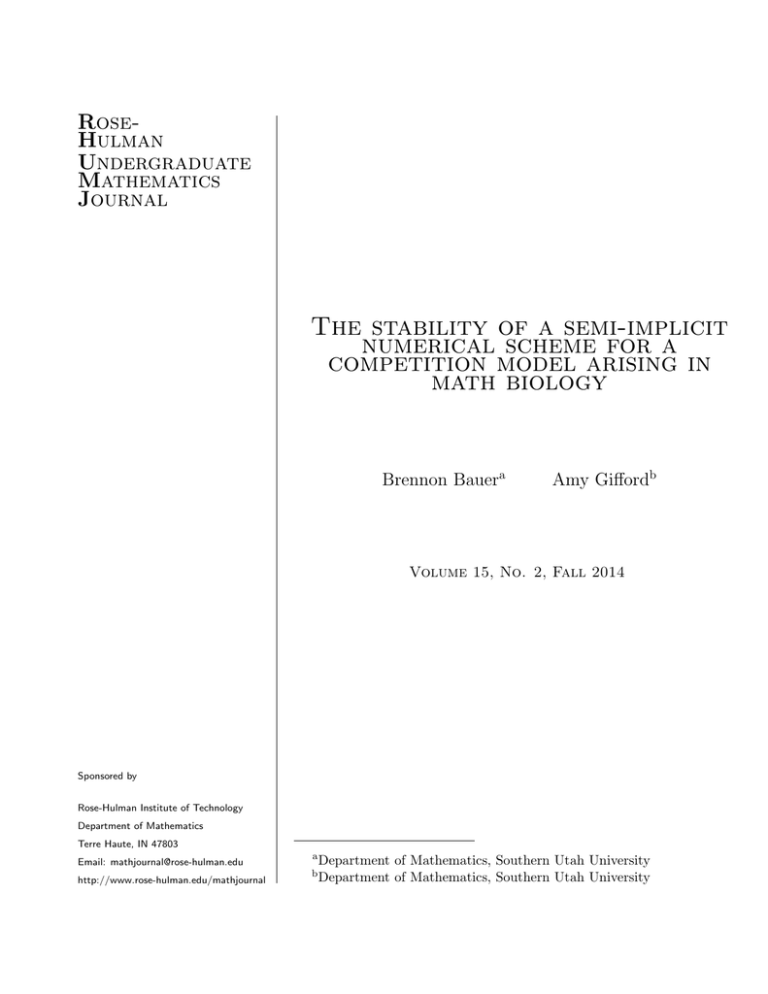
RoseHulman
Undergraduate
Mathematics
Journal
The stability of a semi-implicit
numerical scheme for a
competition model arising in
math biology
Brennon Bauera
Amy Giffordb
Volume 15, No. 2, Fall 2014
Sponsored by
Rose-Hulman Institute of Technology
Department of Mathematics
Terre Haute, IN 47803
Email: mathjournal@rose-hulman.edu
a Department
http://www.rose-hulman.edu/mathjournal
b Department
of Mathematics, Southern Utah University
of Mathematics, Southern Utah University
Rose-Hulman Undergraduate Mathematics Journal
Volume 15, No. 2, Fall 2014
The stability of a semi-implicit numerical
scheme for a competition model arising in
math biology
Brennon Bauer
Amy Gifford
Abstract. We study a Lotka-Volterra competition model. By using the nondimensionalization method, we analyze the stability of the steady state solutions for
this system. Also, a stable numerical scheme is proposed to verify the theoretical
results of the system. Using the Principle of Mathematical Induction, we prove the
unconditional stability and convergence of the numerical scheme.
Acknowledgements: We would like to thank our advisor Dr. Jianlong Han for his
encouragement and helpful discussions. Also, we appreciate our referee’s helpful suggestions.
RHIT Undergrad. Math. J., Vol. 15, No. 2
Page 22
1
Introduction
In biology, there are many different environments in which multiple predators must fight
for the same prey. The following Lotka-Volterra competition model serves as a reasonable
model for an environment where two predators compete for the same prey:
r1
x(K1 − x − α12 y)
K1
r2
dy/dt =
y(K2 − y − α21 x).
K2
dx/dt =
(1)
In this system, x and y are the populations of two different species of predators, r1 and
r2 are growth rates of each species, K1 and K2 are carrying capacities which designate the
maximum populations that the environment can support over a long period of time, and α12
and α21 are interaction terms for the two predators. Note that all of these parameters are
positive constants. Without the interaction terms, each population grows logistically. The
signs on the interaction terms in both equations are negative because these two predators
are competing over resources in the same environment, decreasing the overall rate of change
for each species.
System (1) is similar to the Lotka-Volterra equations
dx/dt = x(a − by)
dy/dt = y(−b + dx)
(2)
that were used to describe the dynamics of biological systems in which two species interact,
one as a predator and the other as prey. System (2) was initially proposed by A.J. Lotka
and V. Volterra in the 1920s, see [5] and [9]. It is still the basis of many models used in the
analysis of population dynamics in ecology.
System (1) is also called a Lotka-Volterra competition model in honor of those mathematicians who made the first breakthrough in math biology. For more detail about the
background of this system, we refer to [1], [4], [8], and references therein.
In order to reduce the number of parameters in this system, we use the following substitutions and apply the nondimensionalization method from [8] to derive a new equation.
2
1
, b = α21 K
, we have
Setting u = Kx1 , v = Ky2 , τ = r1 t, ρ = rr12 , b12 = α12 K
K1 21
K2
uτ = u − u2 − b12 uv
vτ = ρ(v − v 2 − b21 uv).
(3)
In the first part of this paper, we study the stability of the steady state solutions of system (3). In the second part, we develop a numerical scheme which inherits the properties of
the true solution. This numerical scheme overcomes some of the weaknesses of the standard
Euler’s Method. We prove this numerical scheme is uniquely solvable and stable unconditionally. We also prove that the numerical approximation converges to the true solution of
(3). In the last section, we present some results of computational experiments that verify
the stability and convergence of the proposed difference scheme.
RHIT Undergrad. Math. J., Vol. 15, No. 2
2
Page 23
Stability of the Steady State Solutions
Setting the right-hand side of equation (3) equal to zero allows us to find all of the steadystate solutions:
u − u2 − b12 uv = 0
(4)
ρ(v − v 2 − b21 uv) = 0.
Solving, we have four solutions:
(
(
u=0
u=0
v = 0,
v = 1,
(
u=1
v = 0,
(
u=
and
v=
1−b12
1−b12 b21
1−b21
.
1−b12 b21
(5)
To study the stability of these steady state solutions, we use the following theorem, which
can also be found in [8].
Theorem 2.1 Let (u0 , v0 ) be a steady state solution of the system
u0 = f (u, v)
v 0 = g(u, v).
(6)
fu (u, v) fv (u, v)
Let A(u, v) =
.
gu (u, v) gv (u, v)
1. If the matrix A(u0 , v0 ) has two negative real eigenvalues, then (u0 , v0 ) is
asymptotically stable.
2. If the matrix A(u0 , v0 ) has at least one positive real eigenvalue, then (u0 , v0 ) is unstable.
3. If the matrix A(u0 , v0 ) has two complex eigenvalues with negative real parts, then
(u0 , v0 ) is asymptotically stable.
4. If the matrix A(u0 , v0 ) has two complex eigenvalues with positive real parts, then (u0 , v0 )
is unstable.
In order to use Theorem 2.1, we first compute A(u, v) for the system (3):
1 − 2u − b12 v
−b12 u
A(u, v) =
.
−b21 ρv
ρ − 2ρv − b21 ρu
2.1
(7)
Stability of (u, v) = (0, 0)
Substituting u = 0, v = 0 into (7), we have
A(0, 0) =
1 0
.
0 ρ
Solving
1 − λ
0
= 0,
|A(0, 0) − λI| = 0
ρ − λ
we obtain λ = 1 and λ = ρ. Because 1 and ρ are both positive constants, we can conclude
that (u, v) = (0, 0) is unstable.
RHIT Undergrad. Math. J., Vol. 15, No. 2
Page 24
2.2
Stability of (u, v) = (0, 1)
Here we have
A(0, 1) =
1 − b12 0
.
−b21 ρ −ρ
In this case, we find λ = −ρ and λ = 1 − b12 . Thus, we have two cases:
1. If b12 < 1, then we have at least one positive eigenvalue. (u, v) = (0, 1) is unstable.
2. If b12 > 1, then we have two negative real eigenvalues. (u, v) = (0, 1) is stable.
2.3
Stability of (u, v) = (1, 0)
In this instance,
A(1, 0) =
−1
−b12
,
0 ρ − b21 ρ
and we find similar eigenvalues and cases: λ = −1 and λ = ρ(1 − b21 ).
1. If b21 < 1, then there is at least one positive eigenvalue, (u, v) = (1, 0) is unstable.
2. If b21 > 1, then there are two negative real eigenvalues, (u, v) = (1, 0) is stable.
2.4
1−b12
, 1−b21 )
Stability of (u, v) = ( 1−b
12 b21 1−b12 b21
Set d = 1 − b12 b21 . Then we have
1 − b12
1 − b21
A(
,
)=
1 − b12 b21 1 − b12 b21
−1+b12
d
ρb21 (b21 −1)
d
b12 (b12 −1)
d
ρ(b21 −1)
d
!
.
Setting
−1+b12
d −λ
ρb21 (b21 −1)
d
b12 (b12 −1) d
ρ(b21 −1)
− λ
d
= 0,
(8)
we obtain
λ=
ρ(b21 − 1) + (b12 − 1)
2d
p
[ρ(b21 − 1) + (b12 − 1)]2 − 4ρd(b12 − 1)(b21 − 1)
±
.
2d
Now we have the following four cases to consider:
1. b12 < 1 and b21 < 1
(9)
RHIT Undergrad. Math. J., Vol. 15, No. 2
Page 25
2. b12 > 1 and b21 > 1
3. b12 < 1 and b21 > 1
4. b12 > 1 and b21 < 1
In order to interpret each case, we must look at the signs of equation (9). Set
a = ρ(b21 − 1) + (b12 − 1) and k = −4ρd(b12 − 1)(b21 − 1). Then we have the following
equation:
√
a ± a2 + k
.
(10)
λ=
2d
Case 1: b12 < 1 and b21 < 1
If b12 < 1 and b21 < 1, then a and k are√both negative, and d is positive. Now we
can consider the sign of (10). Because a < ± a2 + k if a2 + k ≥ 0, we have two negative
eigenvalues. If a2 + k < 0, then the real part (10) is negative. Therefore, if b12 < 1 and
1−b12
b21 < 1, then ( 1−b
, 1−b21 ) is stable.
12 b21 1−b12 b21
Case 2: b12 > 1 and b21 > 1
If b12 > 1 and b21 > 1, then a and d are negative. So k is positive. Then one eigenvalue
1−b12
, 1−b21 ) is unstable.
of (10) is positive. Thus, if b12 > 1 and b21 > 1, then ( 1−b
12 b21 1−b12 b21
Case 3: b12 < 1 and b21 > 1
If b12 < 1 and b21 > 1, then we must consider two subcases: b12 b21 < 1 and b12 b21 > 1.
1. If b12 < 1, b21 > 1 and b12 b21 < 1, then a can be positive or√negative. However,
since d = 1 − b12 b21 > 0, k is positive. Once again, since |a| < a2 + k, at least one
1−b12
eigenvalue of (10) is positive. So ( 1−b
, 1−b21 ) is unstable.
12 b21 1−b12 b21
2. If b12 < 1, b21 > 1 and b12 b21 > 1, then a can be positive or negative, but since
d = 1 − b12 b21 < 0, k is negative. In this case, we will have two subcases:
√
When ρ|b21 − 1| > |b12 − 1|, in this case a > 0, since a > ± a2 + k and d < 0, both
1−b12
eigenvalues of (10) are negative. So ( 1−b
, 1−b21 ) is stable.
12 b21 1−b12 b21
When ρ|b21 − 1| < |b12 − 1|, in this case a < 0, since d < 0, at least one eigenvalue of
1−b12
, 1−b21 ) is unstable.
(10) is positive. So ( 1−b
12 b21 1−b12 b21
Case 4: b12 > 1 and b21 < 1
We can find the following results for Case 4 using a proof similar to Case 3:
1−b12
1. If b12 > 1, b21 < 1, b12 b21 > 1, and ρ|b21 − 1| < |b12 − 1|, then ( 1−b
, 1−b21 ) is stable.
12 b21 1−b12 b21
1−b12
2. If b12 > 1, b21 < 1, b12 b21 > 1, and ρ|b21 − 1| > |b12 − 1|, then ( 1−b
, 1−b21 ) is
12 b21 1−b12 b21
unstable.
1−b12
3. If b12 > 1, b21 < 1, and b12 b21 < 1, then ( 1−b
, 1−b21 ) is unstable.
12 b21 1−b12 b21
1−b12
Remark 2.2 The stability of the steady state solution ( 1−b
, 1−b21 ) in case 1 and case
12 b21 1−b12 b21
2 is also discussed in [8]. In case 3 and case 4, mathematically we give sufficient conditions
1−b12
, 1−b21 ) which are not included in [8].
of the stability of the steady state solution ( 1−b
12 b21 1−b12 b21
RHIT Undergrad. Math. J., Vol. 15, No. 2
Page 26
3
A Semi-Implicit Numerical Scheme
Since we cannot find the solution to system (3) explicitly, we would like to solve system (3)
numerically using Euler’s Method. First, we discretize the t interval by letting tk = t0 + k∆t,
where k = 0, 1, · · · and ∆t is the step size. We can approximate the population at t = tk by
uk ≈ u(tk ). We have
2
uk+1 = uk + ∆t(uk − (uk ) − b12 uk v k )
2
v k+1 = v k + ∆t(ρv k − ρ(v k ) − ρb21 uk v k ).
(11)
However, when using this explicit numerical scheme, a large initial population value can
imply that the population at time tk will be negative, which does not make sense with our
model.
To correct this potential problem, following the ideas in [1], [2], [3], [6], and [7], we
propose a semi-implicit numerical scheme for this system that guarantees uk > 0, v k > 0 if
u0 > 0, v 0 > 0. The semi-implicit numerical scheme can be written as follows:
uk+1 = uk + ∆t(uk − uk+1 uk − b12 uk+1 v k )
v k+1 = v k + ∆t(ρv k − ρv k+1 v k − ρb21 v k+1 uk ).
(12)
Rearranging (12) to isolate uk+1 and v k+1 , we obtain
(1 + uk ∆t + b12 v k ∆t)uk+1 = (1 + ∆t)uk
(1 + ρv k ∆t + ρb21 uk ∆t)v k+1 = (1 + ρ∆t)v k .
(13)
This gives us the following set of equations:
(1 + ∆t)uk
1 + uk ∆t + b12 v k ∆t
(1 + ρ∆t)v k
=
.
1 + ρv k ∆t + ρb21 uk ∆t
uk+1 =
v
k+1
(14)
Remark 3.1 In (12), we use uk+1 uk and uk+1 v k instead of (uk )2 and uk v k in the first
equation, and we use v k+1 v k and v k+1 uk instead of (v k )2 and uk v k in the second equation.
When uk+1 and v k+1 are isolated on the left-hand side, all negative terms on the righthand side will be moved to the left-hand side. This will guarantee uk+1 > 0, v k+1 > 0 if
u0 > 0, v 0 > 0 no matter how large 4t is. However, the standard Euler’s Method can not
guarantee the positivity of the numerical solutions if u0 and v 0 are too large. Our numerical
scheme will overcome this weakness of (11), since it guarantees positivity of uk+1 and v k+1 .
More examples about this semi-implicit numerical scheme can be found in [1] and references
therein.
RHIT Undergrad. Math. J., Vol. 15, No. 2
4
Page 27
The Stability of the Semi-Implicit Numerical Scheme
Now we will prove that after any time k, our numerical scheme will be nonnegative.
Theorem 4.1 If u0 , v 0 ≥ 0, then uk , v k ≥ 0.
Proof 4.2 Proof by Induction:
If k = 0, by assumption, u0 , v 0 ≥ 0, so our statement is true for k = 0.
Assume our statement is true for k > 0, that is, if u0 , v 0 ≥ 0, then uk , v k ≥ 0. We want
to prove that it is also true for k + 1. In fact, since uk ≥ 0, v k ≥ 0, and ∆t ≥ 0, we have
k
k+1
(1 + ∆t)uk ≥ 0 and 1 + uk ∆t + b12 v k ∆t ≥ 0. Thus, 1+u(1+∆t)u
≥ 0. Similarly,
k ∆t+b v k ∆t = u
12
k+1
v
≥ 0. Therefore, by the Principle of Mathematical Induction, we have proved uk , v k ≥ 0
for all k ≥ 0 if u0 , v 0 > 0.
Now we will prove that given any initial conditions, our semi-implicit numerical scheme
for equation (3) will be unconditionally stable. Here, we use the term “unconditionally
stable” to mean uk and v k will be bounded by some constants which are independent of 4t
and k. There are 4 possible cases for the initial data.
Theorem 4.3 Stability of the Numerical Scheme
1. If u0 ≤ 1 and v 0 ≤ 1, then uk ≤ 1 and v k ≤ 1.
2. If u0 ≥ 1 and v 0 ≤ 1, then uk ≤ u0 and v k ≤ 1.
3. If u0 ≤ 1 and v 0 ≥ 1, then uk ≤ 1 and v k ≤ v 0 .
4. If u0 ≥ 1 and v 0 ≥ 1, then uk ≤ u0 and v k ≤ v 0 .
So the semi-implicit numerical scheme is unconditionally stable.
We begin by proving Case 1 by induction:
Proof 4.4 If k = 0, by assumption, u0 ≤ 1 and v 0 ≤ 1. So our statement is true for k = 0.
Assume that the statement is true for k. That is, if u0 ≤ 1 and v 0 ≤ 1, then uk ≤ 1 and
k
v ≤ 1. We want to show that the statement is true for k + 1, that is, if u0 ≤ 1 and v 0 ≤ 1,
then uk+1 ≤ 1 and v k+1 ≤ 1. We know uk ≤ 1, so
uk ≤ 1 + ∆tb12 v k .
(15)
(1 + ∆t)uk ≤ 1 + uk ∆t + b12 v k ∆t.
(16)
Adding ∆tuk to each side,
RHIT Undergrad. Math. J., Vol. 15, No. 2
Page 28
This implies
(1 + ∆t)uk
≤ 1.
1 + uk ∆t + b12 v k ∆t
(17)
Thus uk+1 ≤ 1. Similarly, v k+1 ≤ 1 and we have our desired result. Therefore, by the
Principle of Mathematical Induction, we have proved the statement in Case 1 is true for all
k ≥ 0.
Case 2: Let k = 0. By assumption, u0 = u0 and v 0 ≤ 1. So our statement is true for k = 0.
Assume that the statement is true for k. That is, if u0 ≥ 1 and v 0 ≤ 1, then uk ≤ u0 and
k
v ≤ 1. We want to show that it also true for k + 1. We know u0 ≥ 1, so
uk ≤ u0 uk .
(18)
uk ∆t ≤ u0 uk ∆t.
(19)
Multiplying both sides by ∆t,
Since uk ≤ u0 + ∆tu0 b12 v k , we can add these terms into (19) to obtain
uk + uk ∆t ≤ u0 + u0 uk ∆t + u0 b12 v k ∆t.
(20)
uk (1 + ∆t)
≤ u0 .
1 + uk ∆t + b12 v k ∆t
(21)
This implies
Thus uk+1 ≤ u0 . Using the same methods as Case 1, we can see v k+1 ≤ 1. Therefore, by the
Principle of Mathematical Induction, we have our desired result for Case 2. Similarly, we
can prove Case 3 and Case 4.
5
The Convergence of the Semi-Implicit Numerical Scheme
Consider the definition of the derivative and Taylor expansion. By using the Taylor Expansion, there exists t ∈ (t, t + ∆t) such that
u(t + ∆t) = u(t) + u0 (t)∆t +
1 00
u (t)(∆t)2 .
2!
Therefore
u(t + ∆t) − u(t)
1
= u0 (t) + u00 (t)(∆t).
∆t
2
00
If |u (t)| is bounded, we have
u(t + ∆t) − u(t)
= u0 (t) + O(∆t).
∆t
RHIT Undergrad. Math. J., Vol. 15, No. 2
Page 29
Using this notation in system (3), we will have
u(t + ∆t) − u(t)
= u − u2 − b12 uv + O(∆t)
∆t
v(t + ∆t) − v(t)
= ρ(v − v 2 − b21 uv) + O(∆t).
∆t
(22)
(23)
T
Discretizing the interval [0, T ] into N subintervals, the length of each subinterval is 4t = N
,
and boundaries of each interval are [ti , ti+1 ], where ti = i4t for i = 0, 1, · · · , N − 1. At each
ti , we have:
u(ti + ∆t) − u(ti )
= u(ti ) − [u(ti )]2 − b12 u(ti )v(ti ) + O(∆t)
∆t
v(ti + ∆t) − v(ti )
= ρ(v(ti ) − [v(ti )]2 − b21 u(ti )v(ti )) + O(∆t).
∆t
(24)
(25)
Let U i = u(ti ) and V i = v(ti ). Then,
U i+1 −U i
∆t
V i+1 −V i
∆t
= U i − (U i )2 − b12 U i V i + O(∆t)
= ρ(V i − (V i )2 − b21 U i V i ) + O(∆t)
(26)
for i = 0, 1, 2, ..., N − 1.
Multiplying through by ∆t, we have
U i+1 − U i = U i ∆t − (U i )2 ∆t − b12 U i V i 4t + O(∆t)2
V i+1 − V i = ρ(V i 4t − (V i )2 4t − b21 U i V i 4t) + O(∆t)2 .
(27)
Similarly, our numerical scheme gives us
ui+1 − ui = ui ∆t − ui+1 ui ∆t − b12 ui+1 v i ∆t
v k+1 − v k = ρ(v k ∆t − v k+1 v k ∆t − b21 v k+1 uk ∆t).
(28)
We want to see how close the true solution (U i , V i ) is to the numerical solution (ui , v i )
from equation (14). Our main result is:
Theorem 5.1 If u0 (0) > 0, v0 (0) > 0, and T > 0, then the numerical solution to (28)
converges to the true solution of (27) uniformly as 4t → 0 on [0, T ] and the convergence
rate is O(4t).
Lemma 5.2 f (x) = (1 + xa )x is an increasing function on (0, ∞) if a > 0 .
Proof 5.3 Note that
a
a x
a
f (x) = 1 +
ln 1 +
−
.
x
x
x+a
0
(29)
RHIT Undergrad. Math. J., Vol. 15, No. 2
Page 30
Consider g(x) = ln x on [1, 1 + xa ]. By the Mean Value Theorem, there exists c ∈ (1, 1 + xa )
such that
a
a
1 a
− g(1) = g 0 (c)[1 + − 1] = · .
(30)
g 1+
x
x
c x
Since 1 < c <
x+a
,
x
we have
1>
1
x
>
.
c
x+a
This implies that
a
1 a
· >
.
c x
x+a
Substituting into (30), we have
1 a
a
a
− g(1) = · >
.
g 1+
x
c x
x+a
(31)
Since g(1 + xa ) = ln(1 + xa ) and g(1) = 0, inequality (31) implies that
a
a
ln 1 +
>
.
x
x+a
(32)
Substituting (32) into (29), we have
f 0 (x) > 0.
Therefore f (x) is an increasing function.
Proof of Theorem 5.1:
Proof 5.4 Subtracting (28) from (27),
U i+1 − ui+1 − (U i − ui )
= (U i − ui )∆t − ((U i )2 − ui+1 ui )∆t
(33)
− b12 (U i V i − ui+1 v i )∆t + O(∆t)2
V i+1 − v i+1 − (V i − v i )
= ρ[(V i − v i )∆t − ((V i )2 − v i+1 v i )∆t
(34)
− b21 (U i V i − ui+1 v i )∆t] + O(∆t)2 .
Now, let E i = U i − ui and F i = V i − v i . From equations (33) and (34), we have
E i+1 − E i =E i ∆t − ((U i )2 − ui+1 ui )∆t
− b12 (U i V i − ui+1 v i )∆t + O(∆t)2
(35)
RHIT Undergrad. Math. J., Vol. 15, No. 2
F i+1 − F i =ρ[F i ∆t − ((V i )2 − v i+1 v i )∆t
− b21 (U i V i − ui+1 v i )∆t] + O(∆t)2 .
Page 31
(36)
Equations (35) and (36) imply that
|E i+1 | ≤ |E i | + |E i |∆t + |((U i )2 − ui+1 ui )|∆t
|b12 (U i V i − ui+1 v i )|∆t + O(∆t)2
|F i+1 | ≤ |F i | + ρ[|F i |∆t + |((V i )2 − v i+1 v i )|∆t
|b21 (U i V i − ui+1 v i )|∆t] + O(∆t)2 .
(37)
(38)
First, we need to estimate |(U i )2 − ui+1 ui |. Factoring and substituting, we have
|(U i )2 − ui+1 ui | = |(U i )2 − U i ui + U i ui − ui+1 ui |
= |(U i )(U i − ui ) + U i ui − U i ui+1 + U i ui+1 − ui+1 ui |
≤ |U i E i | + |U i (ui − ui+1 )| + |ui+1 E i |
(39)
≤ C0 |E i | + C1 |E i | + C2 |ui − ui+1 |.
But |uk − uk+1 | = ∆t|uk − uk+1 uk − b12 uk+1 v k | = O(∆t). So |ui − ui+1 | = O(∆t). Thus,
|(U i )2 − ui+1 ui | ≤ C0 |E i | + C1 |E i | + O(∆t).
Equivalently, |(U i )2 − ui+1 ui | ≤ C2 |E i | + O(∆t). We also need to estimate |U i V i − ui+1 v i |.
|U i V i − ui+1 v i | = |U i V i − U i v i + U i v i − ui+1 v i |
= |U i (V i − v i ) + U i v i − ui v i + ui v i − ui+1 v i |
≤ |U i (V i − v i )| + |v i (U i − ui )| + |v i (ui − ui+1 )|
(40)
≤ C3 |F i | + C4 |E i | + O(∆t).
Substituting (39) and (40) into (37), we now have the following equation:
|E i+1 | ≤ |E i | + |E i |∆t + [C2 |E i | + O(∆t)]∆t
+ b12 [C3 |F i | + C4 |E i | + O(∆t)]∆t + O(∆t)2 .
(41)
Similarly, we can rewrite (38) as
|F i+1 | ≤ |F i | + ρ[|F i |∆t + [C5 |F i | + O(∆t)]∆t
+ b21 [C6 |F i | + C7 |E i | + O(∆t)]∆t] + O(∆t)2 .
(42)
Now, we can add (41) and (42) to derive a new equation:
|F i+1 | + |E i+1 | ≤ |F i | + |E i | + C8 ∆t|F i | + C9 ∆t|E i | + O(∆t)2 .
(43)
RHIT Undergrad. Math. J., Vol. 15, No. 2
Page 32
And if we let C10 = max {C8 , C9 }, then
|F i+1 | + |E i+1 | ≤ |F i | + |E i | + C10 ∆t|F i | + C10 ∆t|E i | + O(∆t)2 .
(44)
Next, let W i = |F i | + |E i |. We have
W i+1 ≤(1 + C10 ∆t)W i + O(∆t)2
W i ≤(1 + C10 ∆t)W i−1 + O(∆t)2
..
.
1
W ≤(1 + C10 ∆t)W 0 + O(∆t)2 .
(45)
Note that W 0 = 0. Therefore
W i+1 ≤(1 + C10 ∆t)2 W i−1 + O(∆t)2 +
(1 + C10 ∆t)O(∆t)2
≤(1 + C10 ∆t)3 W i−2 + O(∆t)2 +
(1 + C10 ∆t)O(∆t)2 + (1 + C10 ∆t)2 O(∆t)2
..
.
≤(1 + C10 ∆t)i+1 W 0 + O(∆t)2 [(1 + C10 ∆t)+
(1 + C10 ∆t)2 + . . . + (1 + C10 ∆t)i ]
(1 + C10 ∆t)i+1 − 1
].
=O(∆t)2 [
C10 ∆t
We claim that [ (1+C10C∆t)
10
In fact,
i+1 −1
] is bounded by a constant.
(1 + C10 ∆t)i+1 − 1
(1 + C10 ∆t)N − 1
≤
C10
C10
T N
)] − 1
[1 + C10 ( N
≤
C10
C11 N
[1 + N ] − 1
=
.
C10
(46)
Since
lim
(1 +
C11 N
]
N
−1
C10
N →∞
and by Lemma 5.2, [1 +
C11 N
)
N
=
eC11 − 1
,
C10
(47)
is an increasing function as N → ∞, we have
(1 +
C11 N
)
N
C10
−1
≤
eC11 − 1
= C12 .
C10
(48)
RHIT Undergrad. Math. J., Vol. 15, No. 2
Page 33
Therefore,
W i+1 ≤ O(∆t)C12 = O(4t).
(49)
This completes the proof.
6
The Numerical Experiments
In this section, we present some results of computational experiments to show that the
proposed difference scheme is stable and gives reasonable solutions.
Case 1: b12 = 0.5, b21 = 0.5, ρ = 1, α = 0.4, β = 0.5.
u(t)
v(t)
0.75
0.7
0.68
0.7
0.66
0.65
0.64
0.62
v−axis
u−axis
0.6
0.6
0.55
0.58
0.56
0.5
0.54
0.45
0.52
0.4
0
5
10
t−axis
15
20
0.5
0
5
10
t−axis
15
20
Figure 1: Solutions for b12 = b21 = 0.5, u(0) = 0.4, v(0) = 0.5.
Note that the interaction rates between the two predators are the same, so neither predator is
significantly stronger than the other. The graph shows that the numerical solution (u, v) will
converge to (0.66, 0.66) which is a stable steady solution of equation (3). This is consistent
with our theoretical results in Case 1 of Section (2.4).
RHIT Undergrad. Math. J., Vol. 15, No. 2
Page 34
Case 2: b12 = 1.5, b21 = 0.5, ρ = 1.
u(t)
v(t)
0.4
1
0.95
0.35
0.9
0.3
0.85
0.25
v−axis
u−axis
0.8
0.2
0.75
0.7
0.15
0.65
0.1
0.6
0.05
0.55
0
0
5
10
t−axis
15
0.5
20
0
5
10
t−axis
15
20
Figure 2: Solutions for b12 = 1.5, b21 = 0.5, u(0) = 0.4, v(0) = 0.5.
In this case, the interaction rate b12 > b21 , so predator v is a stronger animal than predator u,
meaning species u should approach extinction. The graph shows that the numerical solution
(u, v) will converge to (0, 1) which means the first species will die out and the second species
will approach its carrying capacity. This is in agreement with the theoretical result found in
Section 2 where (0, 1) is stable.
Case 3: b12 = .5, b21 = 1.5, ρ = 1.
u(t)
v(t)
1
0.5
0.45
0.9
0.4
0.35
0.8
v−axis
u−axis
0.3
0.7
0.25
0.2
0.6
0.15
0.1
0.5
0.05
0.4
0
5
10
t−axis
15
20
0
0
5
10
t−axis
15
20
Figure 3: Solutions for b12 = .5, b21 = 1.5, u(0) = 0.4, v(0) = 0.5.
The graph shows that the numerical solution (u, v) will converge to (1, 0) which means the
first species will approach its carrying capacity and the second species will die out. This is
in agreement with the theoretical result found in Section 2 where (1, 0) is stable.
RHIT Undergrad. Math. J., Vol. 15, No. 2
Page 35
Case 4: b12 = 4, b21 = 2, ρ = 1.
u(t)
v(t)
1
0.8
0.7
0.9
0.6
0.8
0.5
v−axis
u−axis
0.7
0.4
0.6
0.3
0.5
0.2
0.4
0.1
0
0
5
10
t−axis
15
20
0
5
10
t−axis
15
20
Figure 4: Solutions for b12 = 4, b21 = 2, u(0) = 0.8, v(0) = 0.5.
The graph shows that the numerical solution (u, v) will converge to (0, 1) which means the
first species will die out and the second species will approach its carrying capacity.
References
[1] S. Armstrong and J. Han, A method for numerical analysis of a Lotka-Volterra food web
model
Int. J. Numer. Anal. Mod., Series B, Vol 1(2012), 1-19
[2] P. W. Bates, S. Brown and J. Han, Numerical analysis for a nonlocal Allen-Cahn equation, Int. J. Numer. Anal. Mod., Vol 6(2009), 33-49
[3] D. Dimitrov and H.V. Kojouharov, Nonstandard finite-difference schemes for general
two-dimensional autonomous dynamical systems, Appl. Math. Lett., 18 (2005), 769-775
[4] S-B Hsu, S.P. Hubbell, and P. Waltman A contribution to the theory of competing
predators Ecological Monographs, 48 (1978), 337-349.
[5] A.J. Lotka, Elements of Physical Biology, Williams and Wilkins, Baltiomore,(1925)
[6] R.E. Mickens, Applications of Nonstandard Finite Difference Schemes, World Scientific
(2000), 155-180
[7] R.E. Mickens, A nonstandard finite-difference scheme for the Lotka-Volterra system,
Appl. Num. Math., 45 (2003), 309-314
[8] J.D. Murray, Mathematical Biology I, II (3rd ed), Springer (2003)
Page 36
RHIT Undergrad. Math. J., Vol. 15, No. 2
[9] V. Volterra, Variazioni e fluttuazioni del numero dindividui in specie animali conviventi,
Mem. Acad. Lincei Roma, 2, 31113, (1926). Variations and fluctuations of the number of
individuals in animal species living together. Translation by R.N. Chapman. In: Animal
Ecology. p409-448. McGrawHill, New York, (1931)
